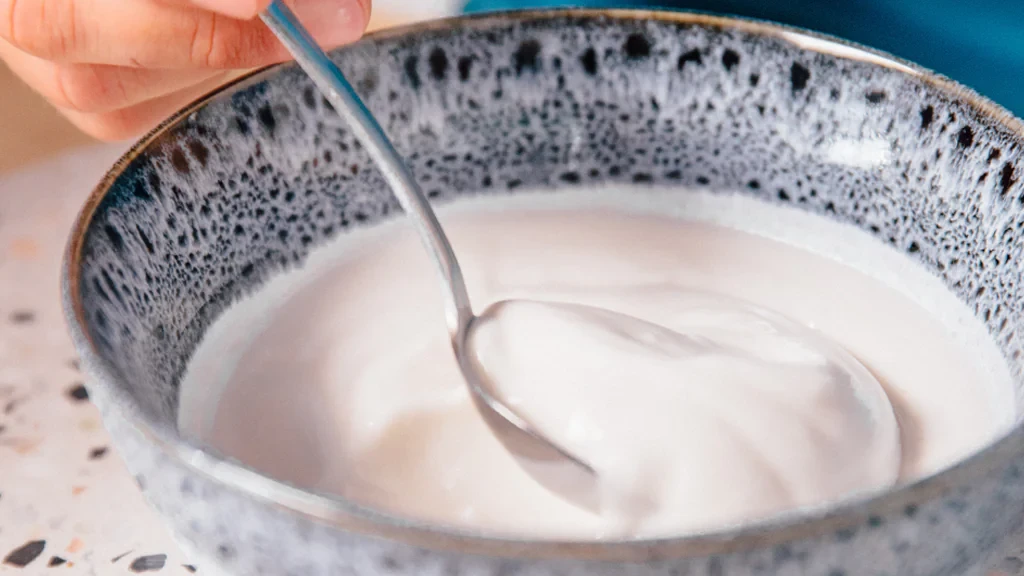Your Cart is Empty
FREE UK SHIPPING
24HR DISPATCH
FREE UK SHIPPING
24HR DISPATCH
FREE UK SHIPPING
24HR DISPATCH

The best dairy free, gut loving, coconut yoghurt recipe
Barb Hodgens
Barb Hodgens loves to cook with alternative, healthy whole food ingredients, with a focus on gut health. Barb has overcome her own gut health issues through healthy eating. Share your ideas, comments and photos at the end of this post :)

COCONUT YOGURT THICKENED WITH GELATIN.
During fermentation, coconut milk does not thicken like dairy yoghurt. So, unless you want a drinkable coconut yogurt, an additive is essential. With the addition of one super, gut-loving ingredient, the steps are virtually the same as the dairy variety and just as easy. See below for the step by step YouTube recipe video.
Gelatin is an animal derived product rich in cell healing amino acids that strengthen the gut lining and therefore lowers inflammation - it's truly the perfect gut-loving thickener. Don’t use any old gelatin though, quality matters. We recommend a premium quality powdered gelatin.
(For a vegan alternative, agar agar works just as well, see the end of this post for instructions). Or click over to our Tapioca thickened coconut yogurt.

WHAT KIND OF COCONUT MILK SHOULD I USE?
When choosing coconut milk, choose additive free and organic and watch out for BPA (an industrial chemical used in plastic). Like almost all canned foods, there is usually toxic BPA in the lining of canned coconut milk. We have had great results with Biona Organics coconut milk but I'm sure there are other organic coconut milk brands that work just as well.
COCONUT MILK WILL SEPARATE - DON'T PANIC!!
A quick word of warning; coconut milk a la natural won’t behave! Straight from the yogurt maker your homemade coconut yoghurt may not look like the consistent, smooth and bright-white, store-bought varieties. Good quality, organic coconut milk will separate, even after fermentation. When refrigerated and left to set, coconut cream will rise to the top and separate from the coconut water. (see the picture below) Don't panic - there is nothing wrong! Depending on the brand of coconut milk you use, the water may be yellowish and you might even get a fine layer of solid coconut oil right on top of the cream. No problem - you can lift this off after it has chilled and whip the layers together!

STARTER CULTURE
You will need a yoghurt starter culture to introduce the fermentation of bacteria to your coconut milk. Use the amount of starter culture indicated on the packet. A good multi-strain probiotic or the contents of a capsule may also be used. Here is a list of SCD & GAPS friendly yogurt starter cultures. For more on probiotics click over to 24 hour yogurt Vs a probiotic pill.
FEED THE BACTERIA SUGAR
In traditional dairy milk yoghurt, the bacteria in starter culture thrive on the sugar (lactose) content, naturally found in milk. The bacteria populating your coconut yoghurt must have something to feed on to allow the culturing process to take place. One teaspoon of sugar or one tablespoon of pasteurised honey is enough to kick start fermentation. Raw honey may have an antibiotic effect and is therefore not suitable for making yogurt.
COCONUT YOGHURT RECIPE
PREPARATION
Thoroughly wash or sterilize your yoghurt container, whisk and other utensils with boiling water.

The best dairy free, gut loving, coconut yoghurt recipe
Luvele
Rated 5.0 stars by 1 users
During fermentation, coconut milk does not thicken like dairy yoghurt. So, unless you want a drinkable coconut yogurt, an additive is essential. With the addition of one super, gut-loving ingredient, the steps are virtually the same as thedairy variety and just as easy. See below for the step by stepYouTube recipe video.
Ingredients
- 3 x 400ml cans of coconut milk (organic BPA free and additive free)
- 1 teaspoon of white sugar or 1 tablespoon of pasteurised honey
- 1 tablespoon (10 grams) of premium gelatin powder
- Yoghurt starter culture or probiotic capsule
Directions
Pour the coconut milk into a large saucepan but leave behind a portion of coconut water from one can.
In a small ceramic bowl combine the gelatin powder and 1/4 cup of the reserved coconut water. Stir and then set aside for 3 minutes to swell.
Add the swollen gelatin powder and sugar/honey to the saucepan of coconut milk.
Place the saucepan on the stove top and gently warm to 95⁰-104⁰F (35⁰- 40⁰C) to activate the gelatin. Stir with a wire whisk to ensure the gelatin has dissolved. Do not boil.
Remove from the heat and pour the coconut milk into your yogurt making glass jar.
Add your preferred starter culture and gently whisk it in. NOTE: if you over heated the coconut milk you must wait until the temperature is within the range above. Adding live cultures to hot liquid will kill the bacteria.
Put the lid firmly on the glass yogurt jar and place into your yogurt maker.
Pour water slowly into the base. (The water must not be filled over the ‘tall line’ indicated on the inside wall of the maker). Then place the cover lid on top.
Use the digital control panel to set the temperature to 38° C, the time to 24 hours and then press ‘confirm’ to begin incubation.
When complete, the yoghurt will be warm, runny and separated. Place the jar in the fridge for at least 6 hours to set. The gelatin will set the coconut water and cream into two layers. This is normal.
Whisk with a spoon or a stick blender to incorporate.
Serve and enjoy
The gelatin set coconut yogurt will last up to 10 days in the fridge.
Recipe Video
PIN THIS RECIPE

The best dairy free, gut loving, coconut yoghurt recipe

COCONUT YOGURT THICKENED WITH GELATIN.
During fermentation, coconut milk does not thicken like dairy yoghurt. So, unless you want a drinkable coconut yogurt, an additive is essential. With the addition of one super, gut-loving ingredient, the steps are virtually the same as the dairy variety and just as easy. See below for the step by step YouTube recipe video.
Gelatin is an animal derived product rich in cell healing amino acids that strengthen the gut lining and therefore lowers inflammation - it's truly the perfect gut-loving thickener. Don’t use any old gelatin though, quality matters. We recommend a premium quality powdered gelatin.
(For a vegan alternative, agar agar works just as well, see the end of this post for instructions). Or click over to our Tapioca thickened coconut yogurt.

WHAT KIND OF COCONUT MILK SHOULD I USE?
When choosing coconut milk, choose additive free and organic and watch out for BPA (an industrial chemical used in plastic). Like almost all canned foods, there is usually toxic BPA in the lining of canned coconut milk. We have had great results with Biona Organics coconut milk but I'm sure there are other organic coconut milk brands that work just as well.
COCONUT MILK WILL SEPARATE - DON'T PANIC!!
A quick word of warning; coconut milk a la natural won’t behave! Straight from the yogurt maker your homemade coconut yoghurt may not look like the consistent, smooth and bright-white, store-bought varieties. Good quality, organic coconut milk will separate, even after fermentation. When refrigerated and left to set, coconut cream will rise to the top and separate from the coconut water. (see the picture below) Don't panic - there is nothing wrong! Depending on the brand of coconut milk you use, the water may be yellowish and you might even get a fine layer of solid coconut oil right on top of the cream. No problem - you can lift this off after it has chilled and whip the layers together!

STARTER CULTURE
You will need a yoghurt starter culture to introduce the fermentation of bacteria to your coconut milk. Use the amount of starter culture indicated on the packet. A good multi-strain probiotic or the contents of a capsule may also be used. Here is a list of SCD & GAPS friendly yogurt starter cultures. For more on probiotics click over to 24 hour yogurt Vs a probiotic pill.
FEED THE BACTERIA SUGAR
In traditional dairy milk yoghurt, the bacteria in starter culture thrive on the sugar (lactose) content, naturally found in milk. The bacteria populating your coconut yoghurt must have something to feed on to allow the culturing process to take place. One teaspoon of sugar or one tablespoon of pasteurised honey is enough to kick start fermentation. Raw honey may have an antibiotic effect and is therefore not suitable for making yogurt.
COCONUT YOGHURT RECIPE
PREPARATION
Thoroughly wash or sterilize your yoghurt container, whisk and other utensils with boiling water.
:recipekit:PIN THIS RECIPE

SUBSCRIBE
Sign up to get the latest on sales, new releases and more …

